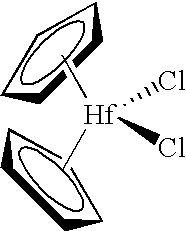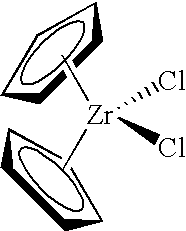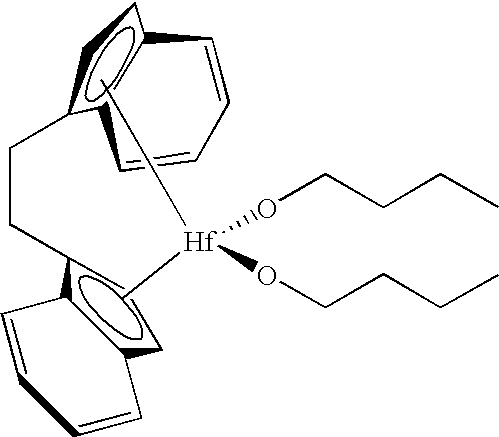Organometal catalyst composition
a technology of organic catalysts and compositions, applied in the direction of catalyst activation/preparation, physical/chemical process catalysts, chemical/physical processes, etc., can solve the problems of large amounts of expensive methyl aluminoxane, low productivity, and inability to commercializ
- Summary
- Abstract
- Description
- Claims
- Application Information
AI Technical Summary
Problems solved by technology
Method used
Image
Examples
##ventive example 1
Inventive Example 1
In example 1, 0.1397 gram of anhydrous TiF4 obtained from Aldrich Chemical Company was charged to the reactor under nitrogen. Then, 2 milliliters of bis(n-butylcyclopentadienyl) zirconium dichloride solution in heptane (0.5 wt %) was added to the reactor followed by 1 milliliter of 1 molar triethylaluminum solution in heptane. One liter of isobutane diluent was added. The temperature was heated up to 90° C., and ethylene was supplied on demand at 550 psig for 110 minutes. Afterward the reactor was depressurized, opened, and 16 grams of white polymer powder were recovered which yielded an activity of 62 grams of polymer per gram of TiF4 per hour.
The polymer was found to have a melt index and a high load melt index of zero. The weight average molecular weight (Mw) of the polymer was found to be very high at 2,866,000 g / mol. The number average molecular weight (Mn) was found to be 243,000, and the polydispersity (Mw / Mn) was found to be very broa...
control example 2
In example 2, the same procedure as in example 1 was repeated except that the TiF4 was omitted. No polymer was produced.
##ventive example 3
Inventive Example 3
Sublimation of TiF4 onto Silica
In example 3, 10 grams of silica described previously were calcined in dry nitrogen at 400° C. for three hours to remove moisture to produce a calcined silica. Then, the calcined silica was cooled to room temperature and physically mixed, by vigorous stirring in the dry state, with 0.10 gram of TiF4 to produce a TiF4 / solid oxide compound mixture. This TiF4 / solid oxide compound mixture was then calcined again under nitrogen at 400° C. for another hour to redistribute the titanium tetrafluoride through sublimation to produce a treated solid oxide compound. Then, 0.2531 gram of the treated solid oxide compound was charged to the reactor along with the organometal compound and the triethylaluminum solution as in example 1. In 91.5 minutes of polymerization, it produced 14 grams of polymer powder.
PUM
| Property | Measurement | Unit |
|---|---|---|
| pressure | aaaaa | aaaaa |
| temperature | aaaaa | aaaaa |
| weight ratio | aaaaa | aaaaa |
Abstract
Description
Claims
Application Information
 Login to View More
Login to View More - R&D
- Intellectual Property
- Life Sciences
- Materials
- Tech Scout
- Unparalleled Data Quality
- Higher Quality Content
- 60% Fewer Hallucinations
Browse by: Latest US Patents, China's latest patents, Technical Efficacy Thesaurus, Application Domain, Technology Topic, Popular Technical Reports.
© 2025 PatSnap. All rights reserved.Legal|Privacy policy|Modern Slavery Act Transparency Statement|Sitemap|About US| Contact US: help@patsnap.com



